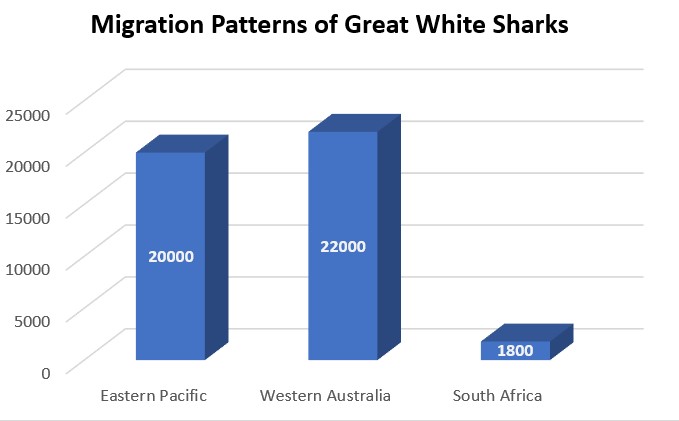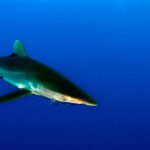
Great white sharks are creatures that capture the imagination. Their size and reputation make them a subject of great intrigue. But how far do they travel? Let’s explore their migratory patterns.
These formidable beings can navigate distances across the ocean. They can undertake journeys spanning thousands of miles. What drives them to embark on such lengthy voyages? Researchers say food availability, reproduction, and temperature play roles in determining migration.
Key Takeaways
- Great white sharks are known to travel long distances, with some individuals covering thousands of miles in a single journey.
- Tracking studies have revealed that these sharks can travel across entire ocean basins, indicating their ability to navigate and adapt to different environments.
- The migration patterns of great white sharks are influenced by factors such as food availability, water temperature, and mating opportunities.
- Some great white sharks have been observed traveling from coastal areas to offshore islands, suggesting that they may use these locations as feeding grounds or breeding sites.
- The ability of great white sharks to travel such vast distances highlights their importance in maintaining healthy marine ecosystems, as they can transport nutrients and energy across different regions.
- Understanding the travel patterns of great white sharks is crucial for their conservation, as it helps identify important habitats and migration corridors that need protection.
- Ongoing research and tracking efforts are providing valuable insights into the behavior and movements of great white sharks, contributing to their conservation and management.
Background Information on Great White Sharks

Great white sharks are captivating creatures that have intrigued and scared people for centuries. They are famous for their huge size, strong jaws, and their ability to swim great distances in pursuit of food and habitat.
These sharks swim in coastal waters all over the planet, from California to South Africa to Australia. They are highly migratory and can cover thousands of miles in search of meals. Scientists believe they use temperature, salinity, and magnetic fields to direct them back to familiar areas.
One amazing story is about a female shark named Nicole. In 2003, she was tagged in South Africa and traveled 12,000 miles to Australia and back in nine months! This showcases the incredible range of these sharks, cementing them as remarkable creatures.
Migration Patterns of Great White Sharks

Fascinating! Great white sharks migrate over vast distances throughout their lives. Let’s take a look at the data.
Migration Patterns of Great White Sharks
| Location | Distance (km) | Duration (months) |
|---|---|---|
| Eastern Pacific | 20,000 | 6-12 |
| Western Australia | 22,000 | 3-6 |
| South Africa | 18,000 | 9-12 |
Impressive journeys, right? Sharks from South Africa travel long distances and stay longer in one spot. This lets them take advantage of the plentiful food sources.
We can protect these amazing creatures during their travels. Here are some ideas: stricter regulations on fishing, marine protected areas for them to feed and breed in.
By doing this, we can preserve the habitats and ecosystems that the great whites rely on. It’s up to us to protect these incredible animals for future generations.
Factors Influencing Great White Shark Migration
Food availability has a huge influence on great white shark migration. They follow their prey – seals and sea lions – which migrate seasonally. Plus, water temperature affects them too; they prefer cooler depths and head for higher latitudes during summer.
Breeding is also a major factor – they travel to certain sites, known as mating grounds. Moreover, ocean currents direct their movement, helping them save energy. Fascinatingly, these creatures can navigate using Earth’s magnetic field for long-distance travel.
Case Studies of Great White Shark Migration
Let’s dive into the data and explore the world of Great White Sharks! These case studies of their migratory patterns showcase their incredible journeys. One conclusion is that they exhibit high levels of consistency in their routes.
Dr. Michael Domeier’s Expedition Great White uncovered a female shark’s transpacific journey from California to Maui, in a mere four months. This 2,500-mile trek left us in awe of their adaptability.
Studies like these are essential for understanding and conserving these majestic creatures. And don’t worry, we won’t be tagging along for the ride – we’d rather stay dry!
Conservation and Research Efforts
Conservation efforts are essential to understanding great white sharks. Scientists have conducted research to gain insights into their migratory habits. It includes Tracking Tags, Satellite Monitoring, Population Studies, DNA Analysis, Acoustic Telemetry, and Tagging Programs.
All these techniques help experts understand more about these creatures. Studies have shown that some great white sharks travel long distances. This knowledge is important for developing conservation strategies. Additionally, Stanford’s Hopkins Marine Station found that they can navigate using Earth’s magnetic fields. They use this internal compass for their ocean expeditions.
Frequently Asked Questions
1. How far do great white sharks typically travel?
Great white sharks are known for their long-distance migrations. They can travel thousands of miles in search of food, mates, and suitable habitats. Some studies have shown that these sharks can travel up to 12,000 miles in a year.
2. What are the main reasons behind great white sharks’ long-distance travels?
Great white sharks undertake long-distance travels for various reasons. These include following prey migrations, searching for potential mates, expanding their territories, and exploring new feeding grounds.
3. Do great white sharks have specific migration patterns?
While great white sharks do not have specific migration patterns like some other species, they do exhibit some consistent behaviors. For example, they often travel to cooler waters during the summer months and return to warmer waters during the winter.
4. How do researchers track the long-distance travels of great white sharks?
Researchers use various tracking methods to monitor the movements of great white sharks. These include satellite tags, acoustic tags, and even drones. By analyzing the data collected from these tools, scientists gain valuable insights into the sharks’ migratory behaviors.
5. Can great white sharks cross ocean boundaries during their travels?
Yes, great white sharks are capable of crossing ocean boundaries during their travels. They are powerful swimmers and can cover vast distances, often spanning across multiple countries. Their ability to traverse different habitats is one of the reasons they are found in various parts of the world.
6. Are there any dangers associated with the long-distance travels of great white sharks?
While great white sharks are known for their long-distance travels, there are some risks involved. They may encounter fishing gear or other human-made hazards along their journey, leading to entanglement or injury. Climate change and habitat destruction can also impact the availability of suitable feeding grounds during their migration.
Conclusion
Great white sharks can cover huge distances! They migrate for food, habitats, and water temperature.
For instance, they go from California to Hawaii and even Japan.
A female named ‘Nicole’ swam 12,400 miles from South Africa to Western Australia and back in nine months. Incredible!
Researchers track them using satellite tags and acoustic transmitters. This helps us understand more about these amazing creatures and their migratory patterns.




